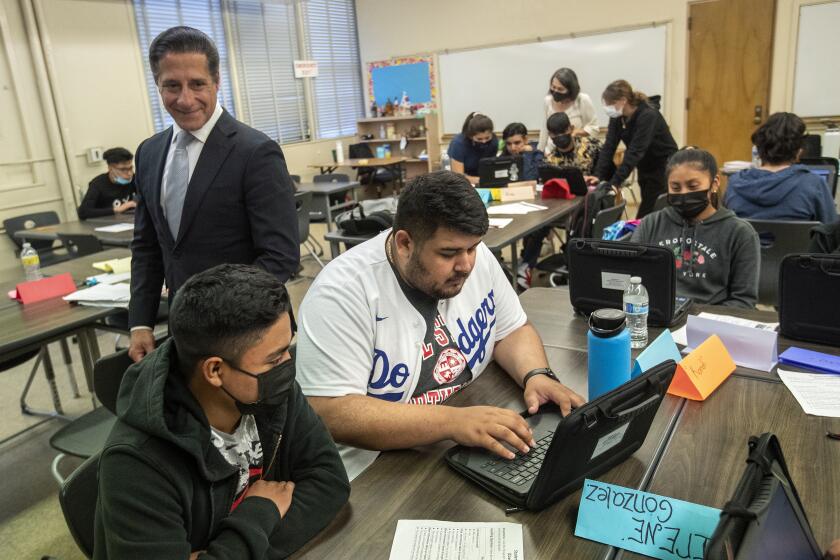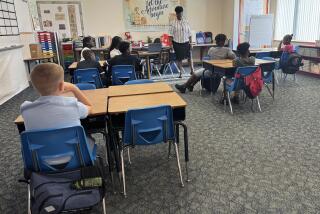These kids want to go to school. The main obstacle? Paperwork

- Share via
ATLANTA — It’s unclear to Tameka how — or even when — her children became unenrolled from Atlanta Public Schools. But it was traumatic when, in fall 2021, they figured out it had happened.
After more than a year of online learning, students were all required to come back to school. Tameka was skeptical the schools could keep her kids safe from COVID-19. One morning, in a test run, she sent two kids to school.
Her oldest daughter, then in seventh grade, and her second youngest, a boy entering first grade, boarded buses. She had yet to register the youngest girl, who was entering kindergarten. And her older son, a boy with Down syndrome, stayed home because she wasn’t sure he could mask.
After a few hours, one school called: Come pick up your son, they told her. He was no longer enrolled.
Around lunchtime, the other called: Come get your daughter, they told her. She doesn’t have a class schedule.
Tameka’s children — all four of them — have been home ever since.
Thousands of students went missing from American classrooms during the pandemic. For some who have tried to return, a serious problem has presented itself. Onerous re-enrollment requirements, arcane paperwork and the everyday obstacles of poverty are preventing those children from going back.
“One of the biggest problems that we have is kids that are missing and chronic absenteeism,” says Pamela Herd, a Georgetown University public policy professor. “I’m really taken aback that a district would set forth a series of policies that make it actually quite difficult to enroll.”
A new data analysis caps a busy week for test scores and found the average student nationwide lost more than half a school year of learning in math and nearly a quarter of a school year in reading. California and Los Angeles Unified generally showed better results.
In Atlanta, where Tameka lives, parents must present at least eight documents to enroll their children. One of them — a complicated certificate evaluating a child’s health — is required by the state. Most of the others are Atlanta’s doing, including Social Security cards and a notarized residency affidavit.
The district asks for proof of residency for existing students every year at some schools, and also before sixth and ninth grades, to prevent students from attending schools outside of their neighborhoods. The policy also allows the district to request residency proof after an extended absence. Without that proof, families say their children have been disenrolled.
Tameka’s kids have essentially been out of school since COVID hit in March 2020. (Tameka is her middle name. The AP is withholding her full name because she runs the risk of jail time or losing custody since her kids aren’t in school.)
Tameka’s partner died of a heart attack in May 2020. His death left her overwhelmed and penniless. Tameka never graduated from high school and has never gotten a driver’s license. But her partner worked construction and had a car.
Suddenly, she had four kids to care for by herself, with only government cash assistance to live on. Because her kids were home during the early days of COVID, she couldn’t work.
When Tameka’s children didn’t return to school, she also worried about the attention from the child welfare department. She says staff visited her in spring 2021 after the school reported her children’s absences.
The social workers interviewed the children, then said they’d be back to set her up with resources. For more than two years, she says, “they never came back.”
During the pandemic, a growing number of families have chosen to home school their children, with an especially large increase in the number of Black home schoolers.
When the kids missed 10 straight days of school that fall, the district removed them from its rolls, citing a state regulation. Tameka now had to re-enroll them.
Suddenly, another tragedy of her partner’s death became painfully obvious. He was carrying all the family’s important documents in his backpack when he died. It was never found.
Slowly, Tameka has tried to replace the missing documents. She says it took more than a year to get Medicaid cards to take her children to the doctor for the health verifications and immunizations the school requires.
When she called for a doctor’s appointment in October, the office said the soonest they could see her children was December.
She also needs to show the school her own identification and a new lease, plus the notarized affidavit. “It’s a lot.”
Tameka says no one from the district has offered her guidance.
Contact logs show school social workers have sent four emails and called 19 times since the pandemic started. Most calls went to voicemail or didn’t go through because the phone was disconnected. Tameka rarely called back.
The only face-to-face meeting was in October 2021, when Tameka sent her kids on the bus, only to learn they weren’t enrolled. A staffer wrote: “Student lost father in May 2020 and only other barrier is uniforms.”
The social worker said the school would take care of the uniforms. “Mom given enrollment paperwork,” the entry ends.
“Our Student Services Team went above and beyond to help this family,” wrote Atlanta communications director Seth Coleman.
In some cities, even during the pandemic, school staff checked on families in person. In Atlanta, Coleman said, the district avoided in-person contact because of COVID.
But Tameka currently lacks a working phone with a cell plan. An Associated Press reporter has had to visit in person to communicate.
The logs provided by Atlanta Public Schools show only one attempt to visit the family in person, in spring 2021. No one was home.
To many observers, Tameka’s troubles stem from Atlanta’s rapid gentrification. The city, known for its Black professional class, also boasts the country’s largest wealth disparity between Black and white families.
“It looks good from the curb, but when you get inside you see that Black and brown people are worse off economically than in West Virginia,” says Frank Brown, who heads Communities in Schools of Atlanta, which runs dropout-prevention programs.
Atlanta’s school board passed many of its enrollment policies in 2008. The schools in mostly white and upper-income neighborhoods were complaining of “overcrowding.”
“But it was also about race and class,” says Tiffany Fick, of Atlanta-based Equity in Education.
The board cracked down to prevent parents living elsewhere from sending their children to those schools.
The Atlanta suburbs, plus communities such as St. Louis, the Massachusetts town of Everett and Tupelo, Miss., have adopted similar policies.
Advocates say the increased bureaucracy makes it difficult for poor students to attend their assigned schools. The AP spoke to five additional Atlanta mothers whose kids were withdrawn because their leases had expired or were month to month, or their child lacked vaccinations.
On a typical school day, Tameka’s children sleep late and stay inside watching television.
The youngest, who should be in second grade, has had to settle for “playing school.” She practices her letters and writes her name. She runs through pre-kindergarten counting exercises on a phone.
Even at 8, she understands it’s not the real thing.
“I want to go to school,” she says, “and see what it’s like.”
More to Read
Sign up for Essential California
The most important California stories and recommendations in your inbox every morning.
You may occasionally receive promotional content from the Los Angeles Times.












